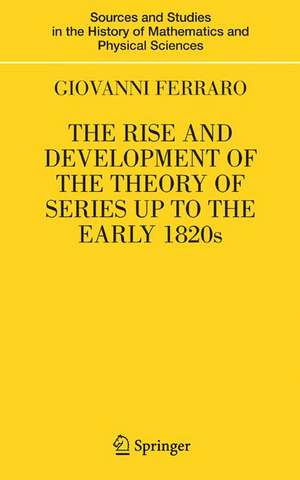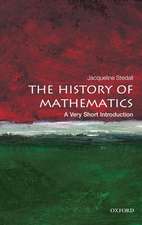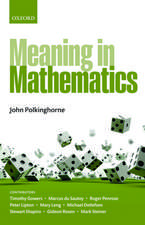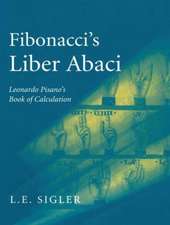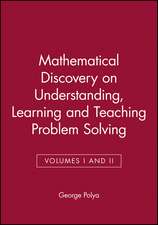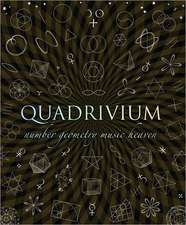The Rise and Development of the Theory of Series up to the Early 1820s: Sources and Studies in the History of Mathematics and Physical Sciences
Autor Giovanni Ferraroen Limba Engleză Hardback – 18 dec 2007
| Toate formatele și edițiile | Preț | Express |
|---|---|---|
| Paperback (1) | 702.24 lei 6-8 săpt. | |
| Springer – 19 noi 2010 | 702.24 lei 6-8 săpt. | |
| Hardback (1) | 649.71 lei 6-8 săpt. | |
| Springer – 18 dec 2007 | 649.71 lei 6-8 săpt. |
Din seria Sources and Studies in the History of Mathematics and Physical Sciences
- 20%
 Preț: 756.13 lei
Preț: 756.13 lei - 18%
 Preț: 907.11 lei
Preț: 907.11 lei - 15%
 Preț: 667.86 lei
Preț: 667.86 lei - 18%
 Preț: 1434.29 lei
Preț: 1434.29 lei -
 Preț: 387.75 lei
Preț: 387.75 lei - 15%
 Preț: 638.57 lei
Preț: 638.57 lei - 18%
 Preț: 896.70 lei
Preț: 896.70 lei - 15%
 Preț: 643.65 lei
Preț: 643.65 lei - 18%
 Preț: 916.25 lei
Preț: 916.25 lei - 18%
 Preț: 1124.92 lei
Preț: 1124.92 lei - 18%
 Preț: 963.29 lei
Preț: 963.29 lei - 15%
 Preț: 652.31 lei
Preț: 652.31 lei - 18%
 Preț: 1244.89 lei
Preț: 1244.89 lei - 23%
 Preț: 636.84 lei
Preț: 636.84 lei -
 Preț: 390.25 lei
Preț: 390.25 lei - 15%
 Preț: 644.18 lei
Preț: 644.18 lei - 15%
 Preț: 580.17 lei
Preț: 580.17 lei - 18%
 Preț: 1123.35 lei
Preț: 1123.35 lei - 15%
 Preț: 641.03 lei
Preț: 641.03 lei - 15%
 Preț: 581.14 lei
Preț: 581.14 lei - 18%
 Preț: 796.31 lei
Preț: 796.31 lei - 18%
 Preț: 2119.49 lei
Preț: 2119.49 lei - 24%
 Preț: 860.16 lei
Preț: 860.16 lei - 15%
 Preț: 645.14 lei
Preț: 645.14 lei -
 Preț: 384.48 lei
Preț: 384.48 lei - 18%
 Preț: 1410.63 lei
Preț: 1410.63 lei - 18%
 Preț: 969.28 lei
Preț: 969.28 lei - 15%
 Preț: 642.03 lei
Preț: 642.03 lei - 18%
 Preț: 1113.71 lei
Preț: 1113.71 lei - 15%
 Preț: 662.16 lei
Preț: 662.16 lei - 18%
 Preț: 963.29 lei
Preț: 963.29 lei - 15%
 Preț: 647.59 lei
Preț: 647.59 lei -
 Preț: 395.63 lei
Preț: 395.63 lei - 18%
 Preț: 941.50 lei
Preț: 941.50 lei - 15%
 Preț: 709.56 lei
Preț: 709.56 lei - 18%
 Preț: 901.26 lei
Preț: 901.26 lei - 15%
 Preț: 695.53 lei
Preț: 695.53 lei - 24%
 Preț: 1244.50 lei
Preț: 1244.50 lei
Preț: 649.71 lei
Preț vechi: 764.37 lei
-15% Nou
Puncte Express: 975
Preț estimativ în valută:
124.35€ • 128.15$ • 104.99£
124.35€ • 128.15$ • 104.99£
Carte tipărită la comandă
Livrare economică 04-18 martie
Preluare comenzi: 021 569.72.76
Specificații
ISBN-13: 9780387734675
ISBN-10: 0387734678
Pagini: 389
Ilustrații: XVI, 392 p. 21 illus.
Dimensiuni: 155 x 235 x 24 mm
Greutate: 0.68 kg
Ediția:2008
Editura: Springer
Colecția Springer
Seria Sources and Studies in the History of Mathematics and Physical Sciences
Locul publicării:New York, NY, United States
ISBN-10: 0387734678
Pagini: 389
Ilustrații: XVI, 392 p. 21 illus.
Dimensiuni: 155 x 235 x 24 mm
Greutate: 0.68 kg
Ediția:2008
Editura: Springer
Colecția Springer
Seria Sources and Studies in the History of Mathematics and Physical Sciences
Locul publicării:New York, NY, United States
Public țintă
Professional/practitionerCuprins
From the beginnings of the 17th century to about 1720: Convergence and formal manipulation.- Series before the rise of the calculus.- Geometrical quantities and series in Leibniz.- The Bernoulli series and Leibniz’s analogy.- Newton’s method of series.- Jacob Bernoulli’s treatise on series.- The Taylor series.- Quantities and their representations.- The formal-quantitative theory of series.- The first appearance of divergent series.- From the 1720s to the 1760s: The development of a more formal conception.- De Moivre’s recurrent series and Bernoulli’s method.- Acceleration of series and Stirling’s series.- Maclaurin’s contribution.- The young Euler between innovation and tradition.- Euler’s derivation of the Euler–Maclaurin summation formula.- On the sum of an asymptotic series.- Infinite products and continued fractions.- Series and number theory.- Analysis after the 1740s.- The formal concept of series.- The theory of series after 1760: Successes and problems of the triumphant formalism.- Lagrange inversion theorem.- Toward the calculus of operations.- Laplace’s calculus of generating functions.- The problem of analytical representation of nonelementary quantities.- Inexplicable functions.- Integration and functions.- Series and differential equations.- Trigonometric series.- Further developments of the formal theory of series.- Attempts to introduce new transcendental functions.- D’Alembert and Lagrange and the inequality technique.- The decline of the formal theory of series.- Fourier and Fourier series.- Gauss and the hypergeometric series.- Cauchy’s rejection of the 18th-century theory of series.
Recenzii
From the reviews:
"Giovanni Ferraro’s book must be regarded as an important contribution to the history of mathematical analysis … . In summary, this book is thoroughly researched; it is written with a high degree of accuracy, and the broad range of fascinating material is, in general, very well organized. Therefore … every college and university library should have a copy. In fact, extracts from the book could be used to inject historical perspectives into courses on analysis, and it will certainly appeal to historians in general." (Peter Ruane, MathDL, April, 2008)
"The work is thoroughly referenced and should prove valuable to mathematical history researchers … . Summing Up: Recommended. Researchers/faculty and professionals." (C. Bauer, CHOICE, Vol. 46 (01), September, 2008)
"The author begins his detailed account with the arrival of the calculus with Newton and Leibniz, and their own treatments of series. … The range of series and functions treated is impressive … . The story stops with a brief notice of the start of the critical phase, especially concerning the convergence (or not) of infinite series, which was put forward by Cauchy and his followers … . The book is a valuable contribution, possibly the single most substantial source on the topic." (I. Grattan-Guinness, Mathematical Reviews, Issue 2008 k)
"Giovanni Ferraro’s book must be regarded as an important contribution to the history of mathematical analysis … . In summary, this book is thoroughly researched; it is written with a high degree of accuracy, and the broad range of fascinating material is, in general, very well organized. Therefore … every college and university library should have a copy. In fact, extracts from the book could be used to inject historical perspectives into courses on analysis, and it will certainly appeal to historians in general." (Peter Ruane, MathDL, April, 2008)
"The work is thoroughly referenced and should prove valuable to mathematical history researchers … . Summing Up: Recommended. Researchers/faculty and professionals." (C. Bauer, CHOICE, Vol. 46 (01), September, 2008)
"The author begins his detailed account with the arrival of the calculus with Newton and Leibniz, and their own treatments of series. … The range of series and functions treated is impressive … . The story stops with a brief notice of the start of the critical phase, especially concerning the convergence (or not) of infinite series, which was put forward by Cauchy and his followers … . The book is a valuable contribution, possibly the single most substantial source on the topic." (I. Grattan-Guinness, Mathematical Reviews, Issue 2008 k)
Textul de pe ultima copertă
The theory of series in the 17th and 18th centuries poses several interesting problems to historians. Most of the results derived from this time were derived using methods which would be found unacceptable today, and as a result, when one looks back to the theory of series prior to Cauchy without reconstructing internal motivations and the conceptual background, it appears as a corpus of manipulative techniques lacking in rigor whose results seem to be the puzzling fruit of the mind of a magician or diviner rather than the penetrating and complex work of great mathematicians.
This monograph not only describes the entire complex of 17th and 18th century procedures and results concerning series, but it also reconstructs the implicit and explicit principles upon which they are based, draws attention to the underlying philosophy, highlights competing approaches, and investigates the mathematical context where the theory originated. The aim here is to improve the understanding of the framework of 17th and 18th century mathematics and avoid trivializing the complexity of historical development by bringing it into line with modern concepts and views and by tacitly assuming that certain results belong, in some sense, to a unified theory that has come down to us today.
Giovanni Ferraro is Professor of Mathematics and History of Mathematics at University of Molise.
This monograph not only describes the entire complex of 17th and 18th century procedures and results concerning series, but it also reconstructs the implicit and explicit principles upon which they are based, draws attention to the underlying philosophy, highlights competing approaches, and investigates the mathematical context where the theory originated. The aim here is to improve the understanding of the framework of 17th and 18th century mathematics and avoid trivializing the complexity of historical development by bringing it into line with modern concepts and views and by tacitly assuming that certain results belong, in some sense, to a unified theory that has come down to us today.
Giovanni Ferraro is Professor of Mathematics and History of Mathematics at University of Molise.
Caracteristici
Carefully researched, accompanied by detailed bibliography Provides a coherent and detailed account of the theory of series in the 18th and early 19th centuries Includes a comprehensive account of many results that were previously scattered throughout the historical and textbook literature
